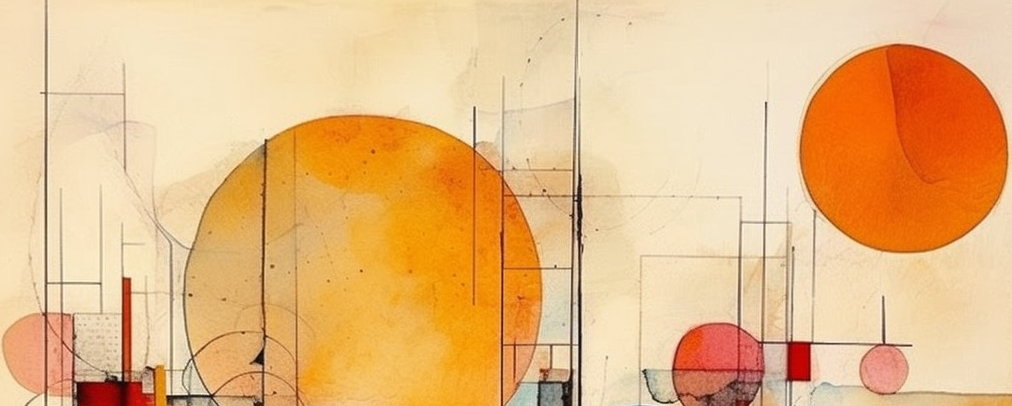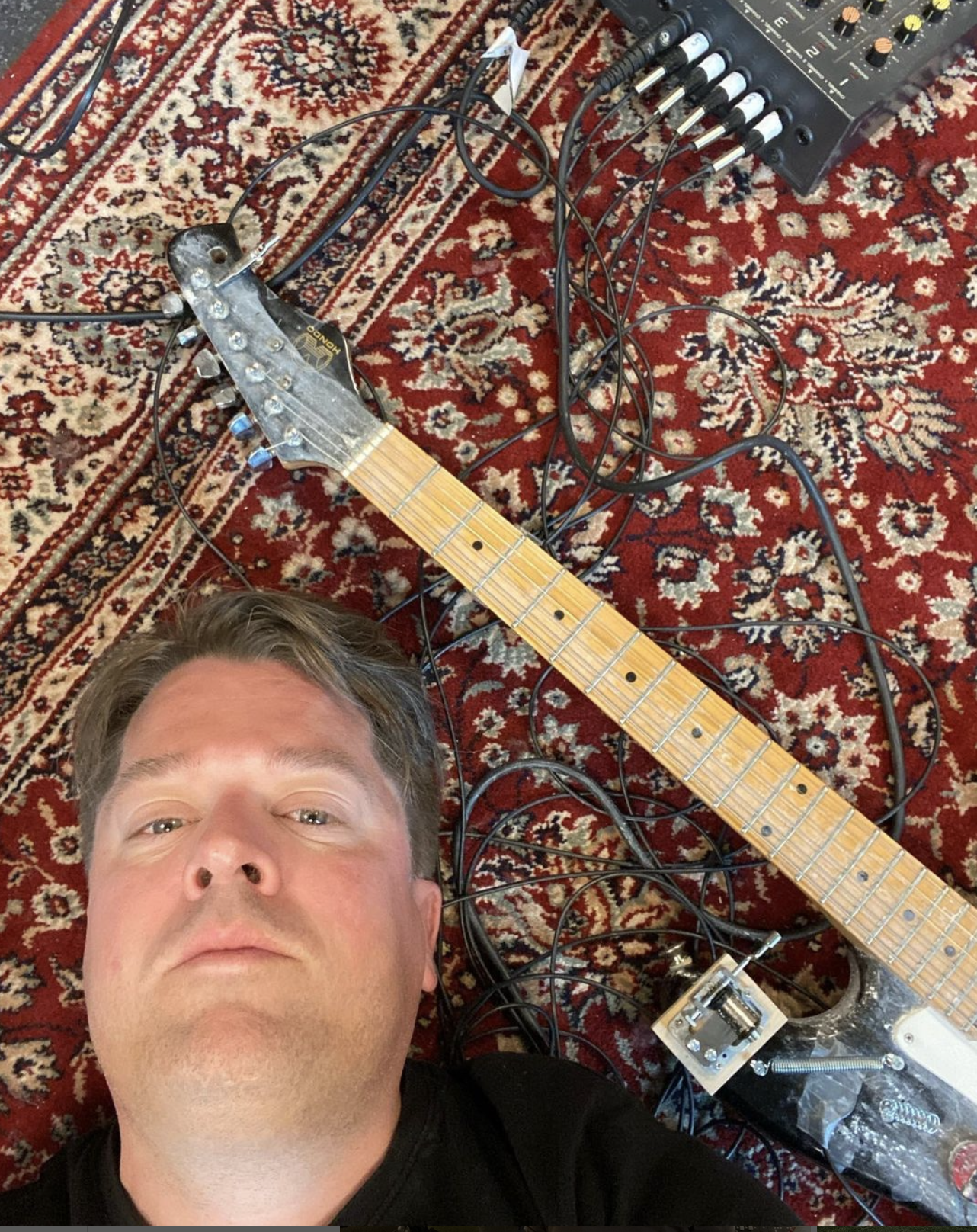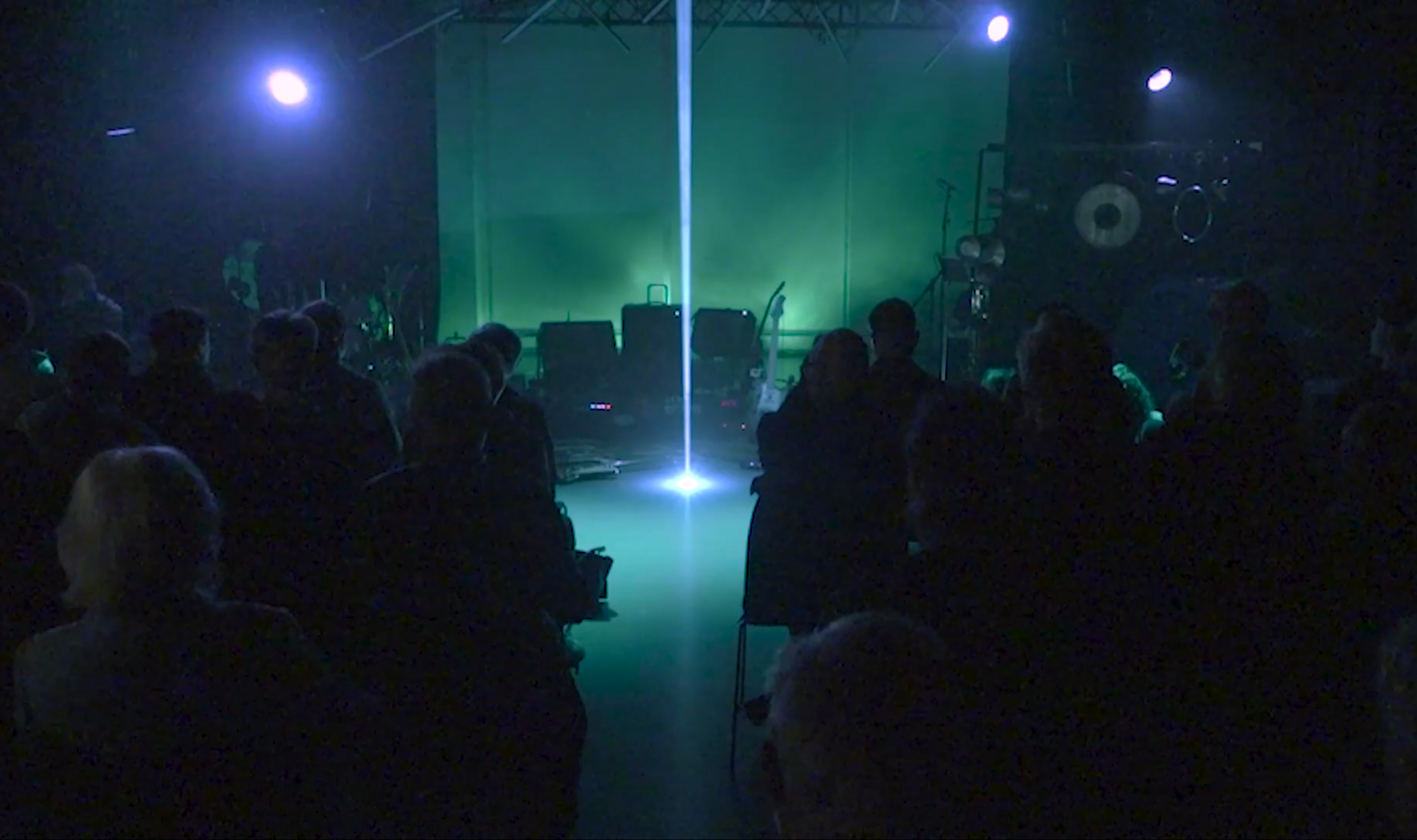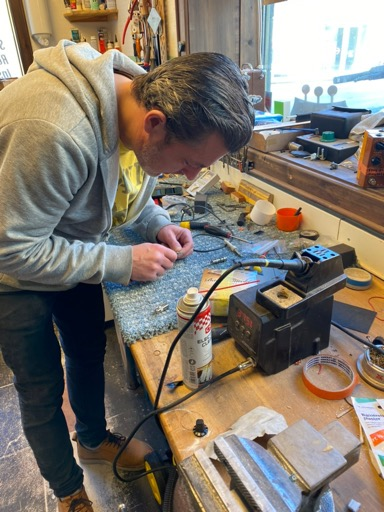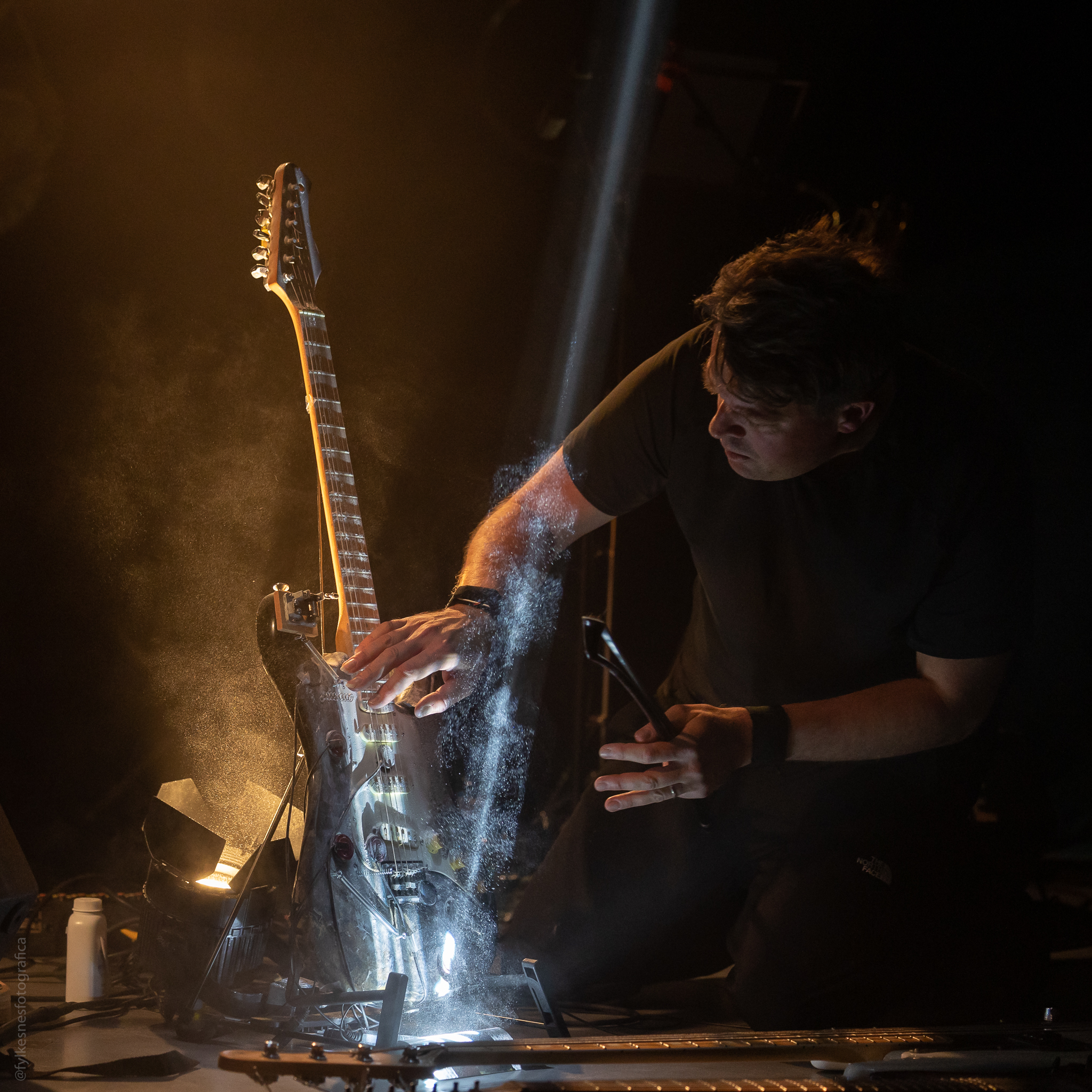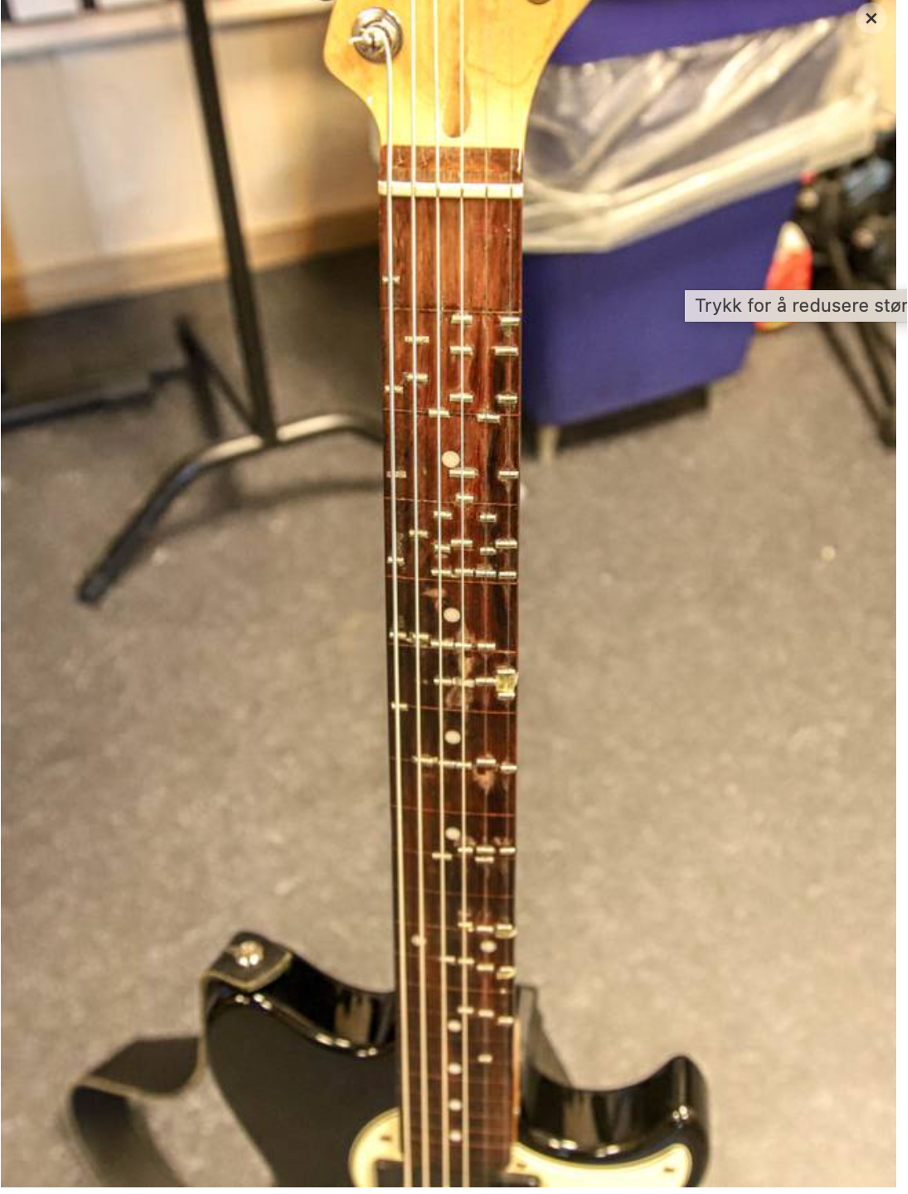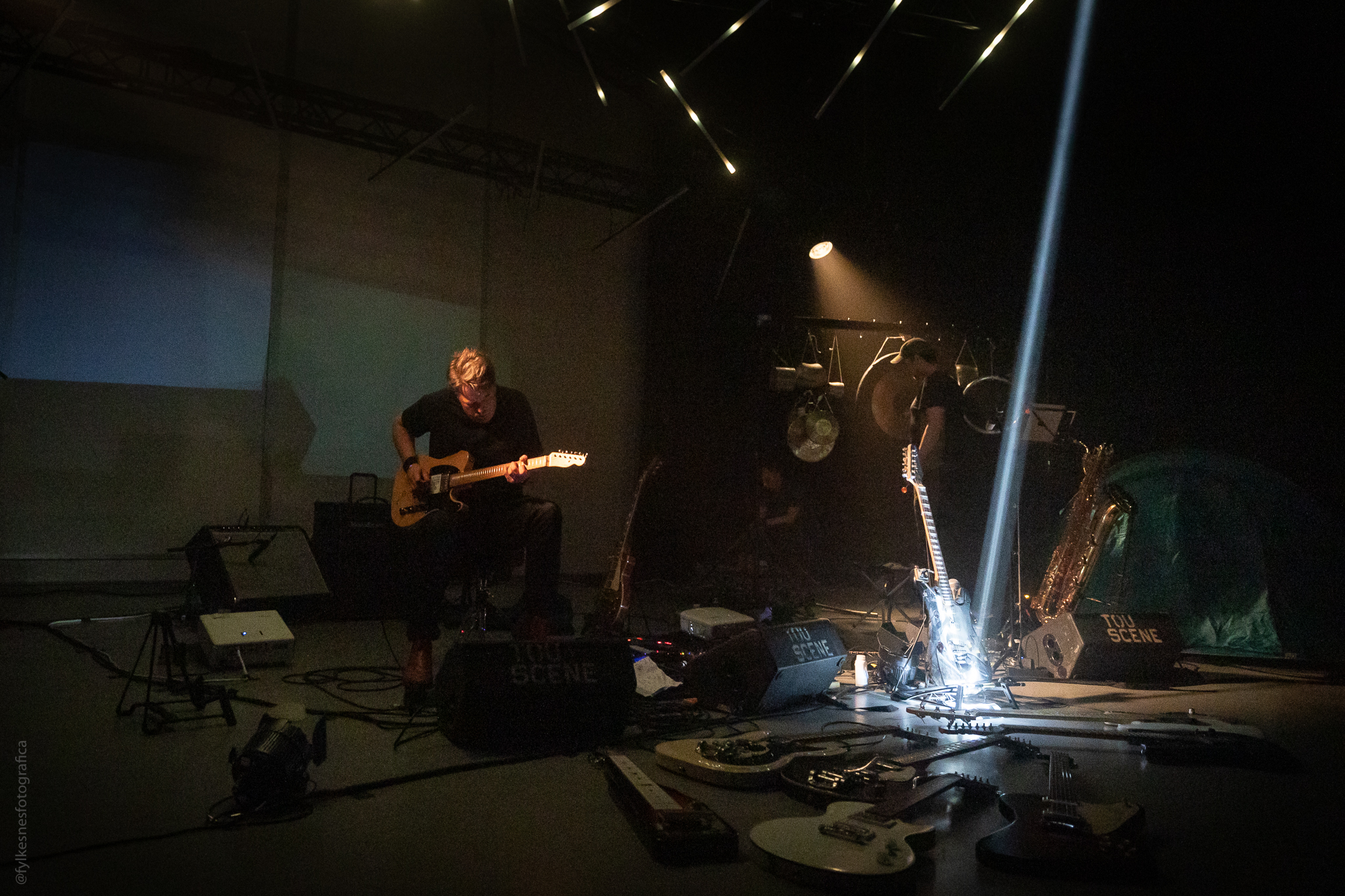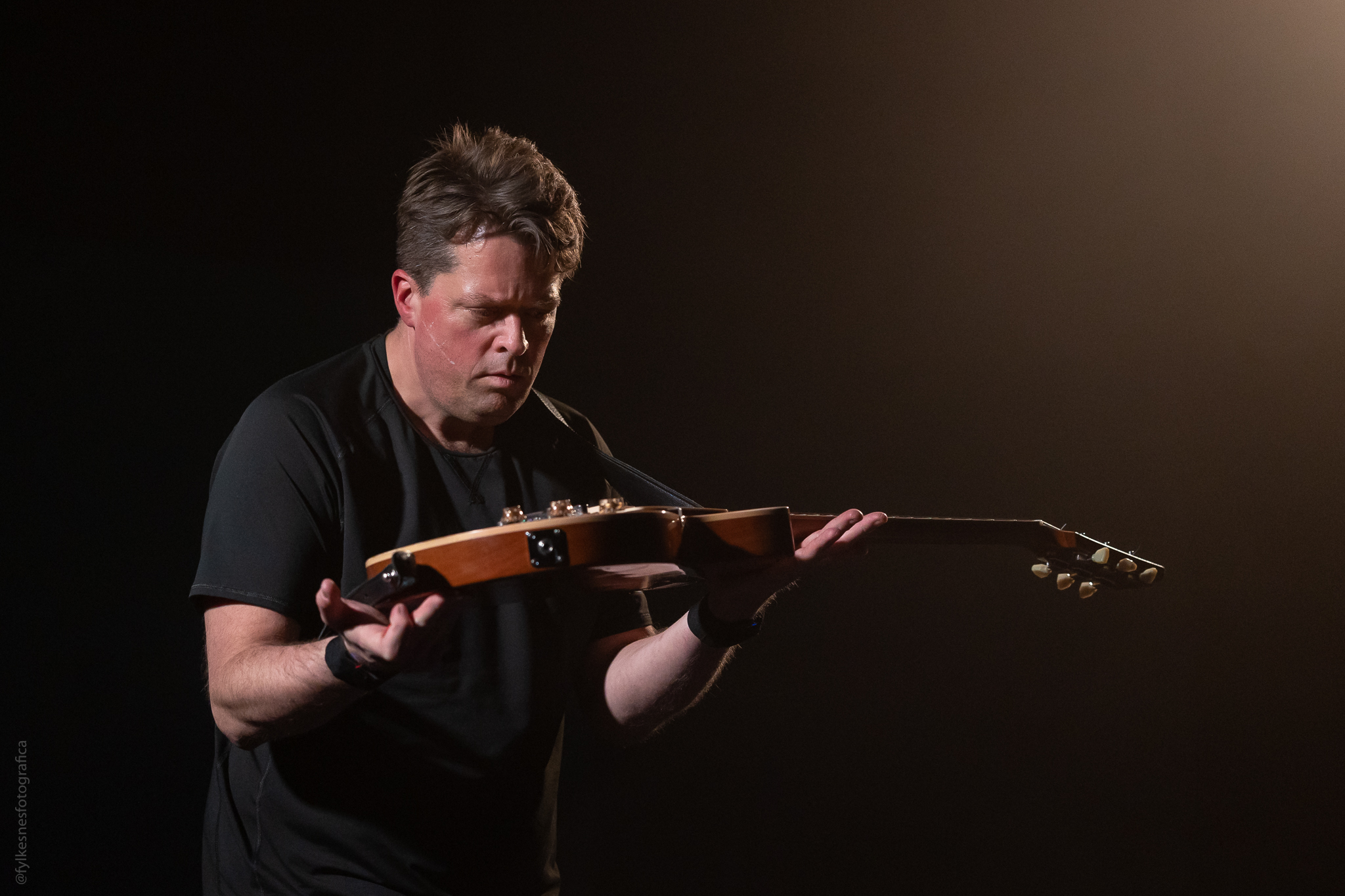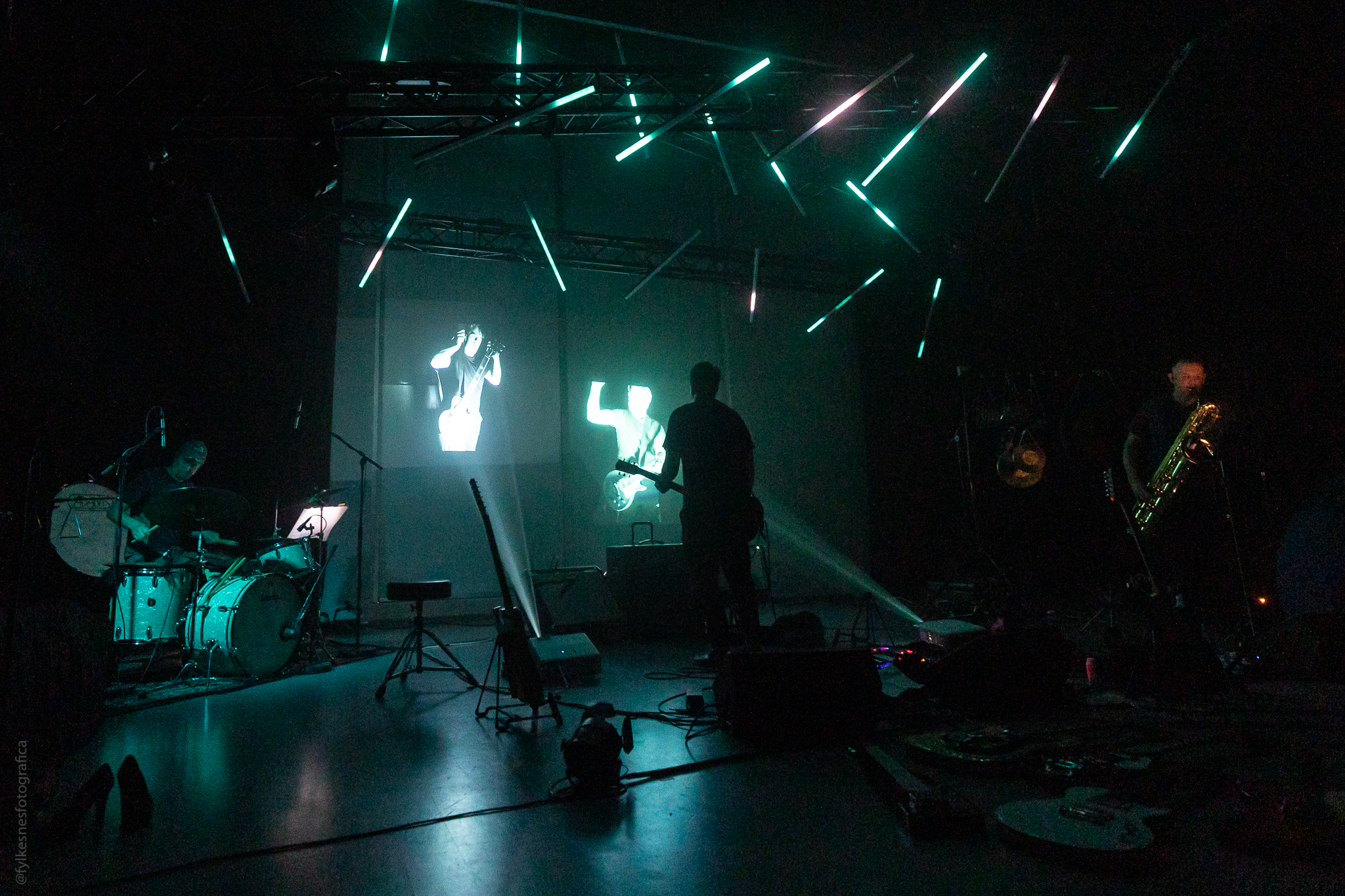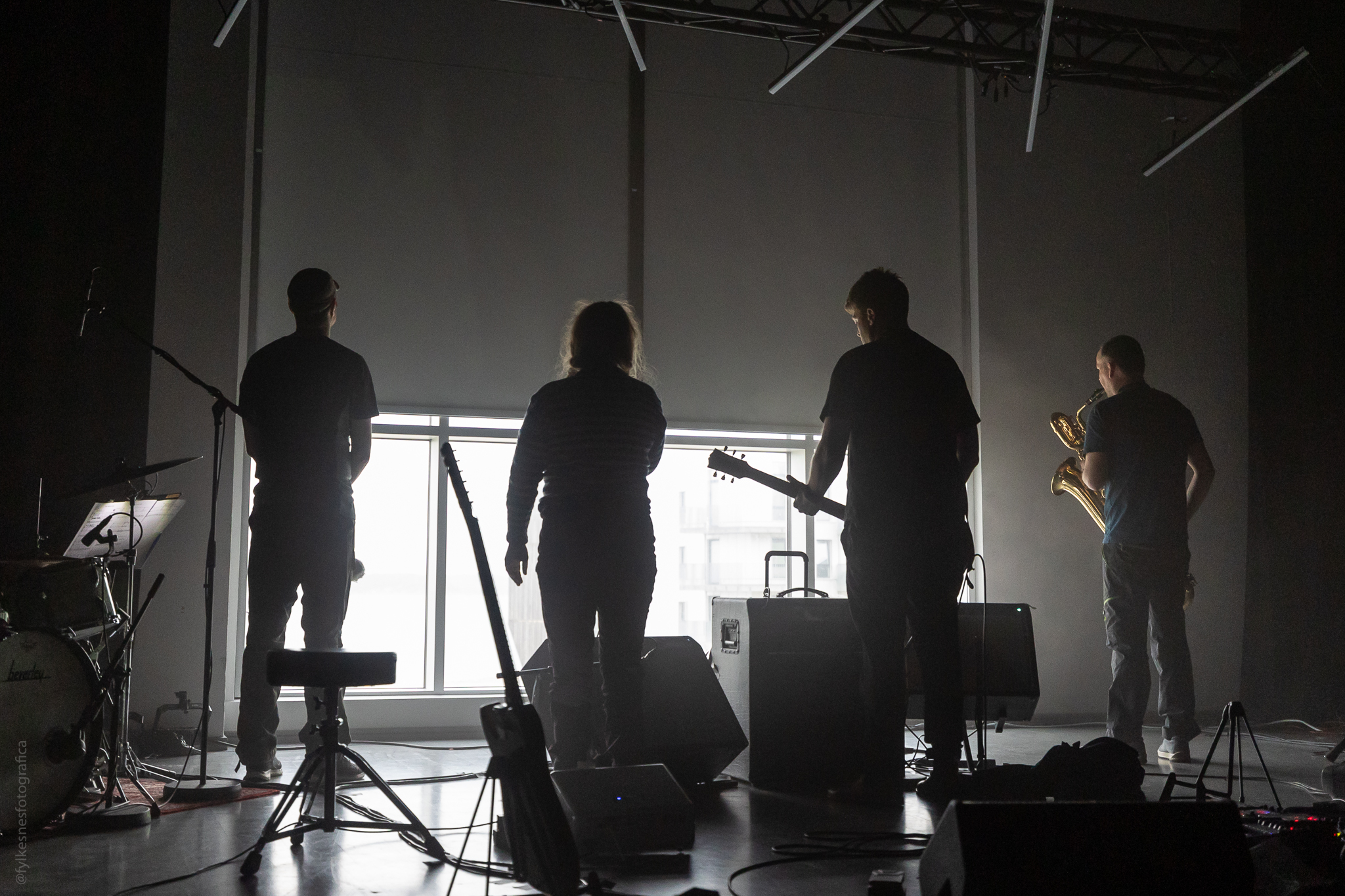1: Introduction
7: Interlude
9: Epilogue
10: References
Composing for the Mechanical Forest 3:
Metahuman and The Mechanical Forest.
In the first two versions, I had already played with the idea of how humans and technology worked together. My setup in this project involves quite a lot of technology, just as my daily life does. As an electric guitarist, I am already depending on «modern»1 technology to produce sound. However, at times during my research period, it felt like me and the electric guitar sometimes could get lost in this forest of human and technology.
The electric guitar is “Primitive in the extreme: six string stretched on a board, hand picked and hand fretted: no moving parts: more rudimentary than a harpsichord; an ancient instrument. But, the instrument is also high technology: electro-magnetic signals, generated by tiny magnets beneath the strings, amplified by electronics and fed to a band of speaker cones. (Waksman, 2001, p. 15)
I missed the feeling of being in the flow zone this almost illusive state I want to achieve when I play my instrument. Mihaly Csikszentmihalyi describes flow in the following way:
In flow, we are in control of our psychic energy and everything we do adds order to consciousness. Following a flow experience, our self becomes more complex than that it had been before, due to two broad psychological processes – differentiation and integration. The self becomes differentiated as the person after a flow experience feels more capable and skilled. Flow leads to integration because thoughts, intentions, feelings and the senses are focused on the same goal. (Csikszentmihalyi 1990)
To me, this is a state where me and my instrument are incorporated. My focus in on the guitar and the music. I am both a performer and a listener. It is easy to play my guitar, it is a part of me. Having said that, I also knew that in this concert, I will break the flow several times. I will play different guitars/extended guitars and change setups several times. In the preparation period, I had to make sure I connected to each instrument in the same way I connect with my Goldtop. This made me realize that it was not necessarily the flow state I was longing for, it was that deep connection with each instrument. Each instrument is a tool, it is technology.
In the documentary The Ister, Bernard Stiegler talks about technology being “just as naturally-occurring as the plants and animals that evolve around us. Mankind branches the divide between what we perceive as biological and what is artificial. We are both because we form a symbiotic system. One cannot function without the other, much like a computer cannot function without a motherboard. (Stiegler, 2004, 4:49-4:51)
One can then argue that a musician being deeply connected to his or her instrument is a natural thing for a human being. It is not an object we must concur, but a tool we grow together with.
In his book, Jazz on the line. Improvisation in Practice, Professor Petter Frost Fadnes talks about the notion of instruments as a vehicle for embodiment being defined by the gradual, nuanced shifts between technology, technique, instinct, and identity (Fadnes. 2020).
He also refers to Australian performance artist Stellarc who utilizes technology as body enhancement by constructing a cybernetic third arm.
Fadnes then draws a line between David Borgos (2016) term neocybernetic: It has become increasingly difficult to maintain the conventional binary between humans and their technological environment: between what we make and who we (thing we) are”, and Evan Parkers idea of biofeedback. By this term, Parker refers to how the instrument “teaches you, as much as you tell it what to do. By hearing the way it’s feeding back to you, you learn to control it better” (in Hopkins 2009).
Creating and preparing for Mechanical Forest 3.0 would have two main points: I would have to work with the extended guitars to reach that transcorporeal state. I also needed to create a concept to organise the concert.
At the start of my artistic research project, my project was about working with compositional techniques from contemporary western art music to see how and if that would expand my improvisational palette. I was not a composer in this situation, «They»[1] were. I was set in the idea of being an improvising guitarist who would mainly work with free improvisation13 in this project. The turning point was after The Mechanical Forest 2-concert, when I realized that this was holding me back. I was expecting that working with free improvisation would give me the freedom to explore how I could use the new knowledge I had acquired. However, it now became clear to me that I wanted to have more control over the music in the Mechanical Forest 3.0 concert for it to become what I wanted it to be.
In his PhD project, “Natural Patterns. Music making with an ensemble of improvisors”, Per Zanussi) talks about composing predetermined music as a “process which takes place out of time, and subsequently the composer can work with time in a different way than the improviser: The improviser works with spontaneity and intuition in real-time, and cannot change something which has been played. The composer, on the other hand, can plan the length and timing of every event in a musical structure if she wants to, change her mind and move sections around as many times as she’d like (Zanussi 2017).
He also talks about how he tried to “discover how to balance my own material (predetermined) with the material of the improvisors (the spontaneous) (Zanussi 2017).
As a composer in my project, I have to find this balance for my musicians, but maybe more importantly; for myself. The composing process has become an oscillating process to me, where I as a guitarist, my guitar, my extended guitars are both influencing and being influenced by my choices as a composer.
Artistic Concept of Mechanical Forest 3.0
I started playing with the idea of technology being an entity in the performance. This entity was telling us to leave our dependence on technology behind and leave the Mechanical Forest. Having created this world, I started composing music using the qualities of each extended guitar, letting them and the way I play them shape the musical ideas and structure.
Musicians
I realized that I needed a safe environment to be able to perform some of the ideas I had. There was one solo section in particular that, even though I would perform it alone, put me in a very vulnerable situation as it was quite physical and personal. I also decided that I wanted to work with a group of musicians who I already had an intercorporal relationship with. Composing is easier to me when I know the qualities of the musician who will perform it. It also makes the playing situation feel more natural as we know each other’s body language while performing. I know what the drummer will play just by having him in the corner of my eye, I feel the tempo of the singer’s phrase by listening to her breathing, and I feel the energy of the saxophonist when he is about to change his improvisation to something else.
This knowledge comes after having played with certain musicians over many years. I choose to work with the last constellation of my band, EGG3, consisting of Ståle Birkeland on drums, Arild Hoem on Saxophones, and the latest edition was Eva Bjerga Haugen on vocal and synths (she is the only musician who has done all three of the Mechanical Forest concerts). The last thing we did together as a group was an album released in 2020 with a following tour in 2020/2021 (I choose not to go into detail how touring was during in this period).
I also share a rehearsal studio with the drummer and saxophonist, as well as being together in the musician pool Kitchen Orchestra, as well as my project where we perform music from Twin Peaks. We all have worked together on several projects over the last 15 years, so I can safely say that these are probably the musicians I feel most comfortable with.
12.05.23 Tou Lyd
As I enter my studio, I am once again greeted by the organized chaos of guitars, pedals, cables, and other artefacts I’m planning to use in the concert. Although I’m here almost every day, walking into this room puts a smile on my face. Even today when I feel exhausted and stressed. I turn on my amplifiers and grab my Goldtop guitar as I do every morning. Instead of doing my warmup exercises, I lay down on the floor while holding it as if I am giving it a long hug. I close my eyes and focus on my breathing. The weight of the guitar makes me feel safe and relaxed. I turn the volume knob up just a bit, and the instrument wakes up. Even the smallest movement I make gets picked up by it. I start knocking repeatedly on a spot 8 centimetres above the bridge. My body dampens the sound, so I calmly get up while the guitar is hanging by the guitar strap. Now the sound opens up, and I can hear how the strings starts to vibrate together as I continue to knock on the same spot. I don’t remember what pickups, type of wood, or how much this guitar weights. But I know where to knock to get a specific sound, and I know how to make it sound like the wind blowing across a forest by gently letting my fingers slide over the low strings. I know how to move to change the tone of a feedback, and as I close my eyes, the connection becomes even stronger. This is how I want to feel when I’m on stage.
The Music of Mechanical Forest 3
In this chapter, I will go through each piece of the concert. I will talk about the initial ideas and how they developed over time.
I decided to compose a coherent piece where I could use all the extended guitars I have developed during my research period. I wanted to create a world where I could be as close to my instruments as possible.
Piece 2: Collection (Collection, Mutate, Breathe 3.0)
In this piece, I used Rolf Wallin’s Crystal Chords2 to create a synthetic scale. The system is based on three intervals, that are multiplied and stacked on top of each other. The Crystal Chord does not repeat itself at the octave but keep evolving in unpredictable ways. Wallin uses the term “consonant atonality” to describe the sound of the scales it creates. (Wallin, 1998)
25.05.23 20:02 Tou Scene.
I can hear the audience coming in. I’m sitting on the stage floor surrounded by my pedal boards, guitars and amplifiers. I feel calm and relaxed, and I find the smell from the smoke machine calming. I don’t look at the audience, but I rest my eyes on the guitars placed on the floor. In a few of minutes, I will turn on my head lamp, pick up the handheld pickup and place my feet gently in the middle of the guitar park. But first…Eva’s monologue.
Machine: This is it.
Eva:I have been watching you for a long time now. It is time that I let you know. I have to let you know.
Machine:«Ever had that feeling of being watched? «
Eva:You see that wall there? That…sort of…wall shaped wall? It’s not really a wall at all. Not a wall at all.
25.05.23 20:04 Tou Scene.
This really is it. Four and a half years of work. I became a dad, got my driver’s licence, and lived through a global pandemic during my research period. Now I’m sitting on the floor on a stage I have a long history with, both as a performer and as an audience. Tou Scene. This place was one of the reasons I decided to move back from Leeds to Stavanger 15 years ago. This is the place that allowed me to grow as an artist. The first time I visited this place, and actually this actual stage was at a festival called Nu Music. Tou Scene used to be the local brewery before it was made into an art arena. I remember coming into this room in 2005 during a concert with the French band Nouvelle Vague. There was a lot of holes in the concrete wall behind them and big chunks of concrete all over the room (and stage). The light designer used this worn out building to create fantastic images. I had never seen anything like this before in Stavanger. This place feels almost a bit dangerous. I remember the text I got from my research fellow Kristoffer Alberts a few hours earlier. He wished me good luck and told me to try to enjoy it. He did his final artistic presentation a month ago (also at Tou). Lucky man. This is it. Breathe…
I eventually took seven different guitars and tuned them each in an open tuning based on Wallins scale.
|
Fender 7 String |
Ab E Ab D G Ab D |
|
Fender Bass |
E F D F |
|
Gretsch Lapsteel |
F C D F C F |
|
Gretsch Baritone |
H D F# C# F Bb |
|
Gibson Firebird |
E C Eb F# H D |
|
Gibson Fretless |
Eb Bb C G A E |
|
Richmon |
D G C F# H Eb |
Placing the guitars on the floor, I could now move around using the pickup (which is connected to my guitar set up, using a delay, reverb, and an overdrive pedal) on each guitar. The guitars are not connected to any other sound source, so the only way for them to produce a sound (other than the low sound any of these electric guitars creates acoustically) is for me to move the pickup close to the strings. The open tuning means that I can use my right hand to set off the strings while moving the pickup with my left hand, producing a swelling sound, like the sound created by using a volume pedal.
This guitar setup dictates the way I must move and play them. Just as with the Broken Guitar, the materiality of the instruments (including the hand hold pickup) shapes the music as well as the visual aspect of the performance.
I had the idea of using a handheld pickup earlier in my research project, but at the time I was thinking about using it on my conventional guitar. I realized that the musical effect would be too similar to be using a volume pedal, and it would mean that I would only have one hand to actually play the guitar. The visual gain did not surplus the impracticality at this point.
I could never really let go of using a handheld pickup, and as I was trying to figure out a way I could use it, I remembered another idea I had early in my research project: A Lap steel guitar5 tuned in a synthetic scale. I used this live only once. At the time, i played it quite conventionally, sitting with it on my lap and using a slide. This type of guitar is usually tuned in an open tuning6, so I created a scale that sounded interesting while strumming. The idea did not work as well as I imagined, as the scale lost its tonal identity as soon as I started using the steel bar. But just like the idea of the handheld pickup, I couldn’t let the idea of a guitar tuned in some sort of a chordal way, based on the notes from a synthetic scale go. So, when I had the handheld pickup made, the first guitar i tried it on was my Lap Steel. I kept adding guitars, tuned them by using the same scale, until I had a selection of guitars that when combined, became one instrument, connected not by cables, but in tonality and the fact that they are placed on the stage floor.
The way I play these guitars is similar to being in dark forest at night, holding a flashlight. You can never see the whole scenery of the forest at the same time, but as you highlight different trees, plants, rocks and the forest floor, you can put the pieces together and find your way either out of the forest, or further in. The handheld pickup is my flashlight in The Mechanical Forest.
25.05.23 20:06 Tou Scene.
The introtape is getting close to the end. I’m sitting on the floor with my eyes closed, getting ready to create the first sound from the guitars on the floor. I switch on my headlight and step over my pedal board and monitors. I set of the first swell and can hear how the sound starts to fill the room. Don’t stress this Vidar. Take your time. Remember the two words you wrote down a week ago to help you focus and relax in this rather stressful situation that is a PhD-concert: Don’t overcomplicate, don’t overcompensate.
I cherish some of these guitars, and it’s a bit scary to place them on the floor like this. If I step on them, I can easily break the neck, let’s try not to do that. As strike a chord on the Gretsch Baritone, I hear an echo of the music of Twin Peaks. The last time I used this on stage was while playing excerpts from the soundtrack with a Symphony Orchestra. I love the sound of this guitar, so dark and clear. I can’t hold back the temptation to use the tremolo bar to add to the Twin Peaks memory.
As I move to the seven-string guitar, I have to be a bit more careful. The pickup tends to be pulled to the strings quite strongly on this one, but it is also the one that produces the least sound acoustically, so I still must get quite close to it. It got to close and hit the strings…but it’s ok, it just added to the timbre.
These guitars have never played together before at a concert. As I let them ring together, I create a timbre which to me creates a mosaic of memories. The white Richmond guitar I travelled with all over Europe and Japan gave me tendonitis on the last tour I used it. It has been packed away for 8 years until I needed it for this project. It still has the same smell, and there was still a guitar pick taped to the back by the guitar tech on that tour. I even bring the Broken Hondo guitar into the guitar orchestra. It’s not tuned in the same scale, but I know that one of the springs I have attached to it creates a deep bass tone which will add a low end to the timbre.
I have a story with all these guitars, some more than others, some of them has never been used live before in my possession and others have been on a selection of small clubs and huge stages, hotel rooms, airplanes, trains, cars, and busses. Even the guitar pickup I’m holding has a story. This is taken from the first Gibson guitar I bought, an ES-335 I got when I was a jazz student in Leeds 20 years ago. The guitar itself is the only guitar I have in my house at the moment, and I was not comfortable to put it on the floor as it could easily break. I changed the pickups on the guitar to use it on a pop tour some years ago, so the one I’m holding is the original. So even though the guitar is not present, it is still the one that ties all the other guitars together.
I let the last chord ring as I put down the pickup and leave them behind. It’s time to become the Goldtop.
Piece 3: Broken Guitar
This was the 5th time I use The Broken Guitar in a concert. This is an instrument under constant development. When I used it in Mechanical Forest 2, I used pitched delays and reverb from an Ableton Live project. However, I missed the opportunity of being able to switch and/or manipulate the effects. Even though I have different sounds which are produced acoustically on the instrument, I found it hard to create variation in my improvisation. The first time I used it, I connected it to my pedalboard and guitar amp, which meant that I could switch and manipulate the effects the way I would normally do. While preparing for Mechanical Forest 3, I decided to try this setup again. I quickly realized that I was used to the clear and uncompressed sound produced when I connect it directly to my sound card. I also found the sound to be too similar to the sound I use on my conventional guitar. I want the Broken Guitar to have a unique sound, a sound that is separated from the sonic environment I create on the guitar which, after all, is not broken. If I use it the same way as my Gibson Goldtop, I treat it as a functional guitar, thereby making it into a normal guitar again.
I then decided to build a new setup on my computer, using the software MainStage(2) as an effect unit(3). The basic effect of the setup is combining a reverb and a pitch delay. This setup resembles the sound I used the previous performance. The other effects are what I would call signature effects, meaning that they have a strong auditive identity. These types of effects can change the sound of your output signal completely, which again can lead to the same issue I had with the previous version of the instrument, the lack of variety. The easiest solution to this issue would be to place my computer close to the instrument, giving me the opportunity to work with the effects at the same time as I play it. However, this would change the visual aspect of the instrument. If I keep reaching for my computer, shifting my focus away from the Broken Guitar over to the computer screen, this would remove me from the bubble I imagine I am in while playing. It will also give me more control over the instrument, which is going against my idea of it being a broken piece of technology. I want the instrument to be unpredictable, both for me as a player, as well as for the audience. The focus should be on the instrument and my interaction with it. I want to create the illusion that it is the instrument that creates all the sound.
However, I still wanted to be able to in some way manipulate and change the effects. The solution was to outsource the task to someone else in the ensemble. The saxophonist in the ensemble, Arild Hoem, uses the computer, which is placed in a different part of the stage. When he operates the effects, the instrument will be even more unpredictable, and I must react to whatever it does. I would have found this situation to be frustrating if it had been on my Goldtop, but with the Broken Guitar, watching how a gentle touch from my hand can grow into something completely different than I anticipated, is the nature of the Broken Guitar.
In addition to the effect part of the Broken Guitar, I also wanted to add the possibility to use my voice in the playing process(4). I have followed the work of the Norwegian artist Christian Blandhoel, and found his way of rebuilding guitars to be inspiring. Among (many) other things, he creates feedback producing/noise producing guitars by fitting speakers, noise fuzz and other effects directly on the guitar itself. For my purposes, these types of guitars tend to lean too much into noise music, but I like how he rebuilds and then repurposes the guitars in a quite rough way.
Inspired by Blandhoel, I first attached a Talk box(5) on to the Broken Guitar. The long plastic tube, and the pedal itself complimented the visual concept of the instrument, but it proved to be too impractical as well as producing an unwanted high frequency feedback. Luckily, the idea of creating a sophisticated instrument with sophisticated technical solutions was not what I was aiming for in this project. The solution was gaffing a Shure SM58 vocal microphone to the back of the guitar. The signal from this microphone goes into the same mixer and effect setup as the contact microphones. This way, I can now lean into the guitar and add to the sonic world of the Broken Guitar with my voice.
The main sound input of the Broken Guitar is a set of contact microphones. These microphones are very sensitive to sound waves produced by physical touch. This means that it reacts to my stomping feet when I walk towards them, not just when I physically touch them. In this way, the instrument has a life of its own. It might trigger sounds, even though I don’t plan for it to do so. The instrument reacts to its surroundings, it reacts to me and my movement.
I approach this guitar as if I am finding an old piece of technology from another world. The instrument looks very similar to a guitar, but it does not play like a normal guitar. The act of playing it is the act of exploring it.
I chose to treat this piece as an open improvisation. I wanted the rest of the ensemble to join both in complimentary as well as contrasting improvisation. We spend a lot of time on getting to know the instrument in rehearsals.
Similar to when I’m playing the guitar park, I don’t wear this guitar, I’m kneeling down in front of it while it’s seated on a guitar stand, almost as if it’s on a throne. This changes the dynamic between my body and the guitar. In the text “Spatio-Motor Thinking in Playing Folk Blues Guitar”, the authors talk about a musical instrument being a type of transducer, converting patterns of body movements into patterns of sound (Baily J. & Driver P. 1992). After having spent a lot of time with this guitar, I have developed a way of playing it based on the morphology of the instrument. The act of playing this instrument has become a very intimate experience. I touch it almost as if it is a living creature. I sing and breathe into the guitar, as if I am giving it life.
Tinkering
I seldom change anything on my guitars. I’m not particularly handy, and I never had the desire to learn how to work with the electronics, adjusting the guitar neck, change pickups or any other way of rebuilding the guitars I have. Steve Waksman talks about how guitarist often take part in what he describes as the tinkering process.
As professional guitarist, we often have to play in different musical styles, so we have to find ways to adjust our sound towards different musical settings. This can involve rearranging technical details on the guitar, amplifiers or by constantly changing the pedal chain (Waksman 2004). My tinkering is usually focused on how I arrange and rearrange my effect pedals, depending on what projects I’m working on. The Broken Guitar is my first attempt to rebuild/upcycle a guitar myself, and the way it was done is a great example of why I didn’t become a carpenter, or a guitar builder for that matter.
I never considered re-fretting the Quartercaster into a quartertone guitar myself, I left that job to professionals. But I could not have given them the task of rebuilding the Hondo into the Broken Guitar, that was my own tinkering project, and it was supposed to be a “do it yourself” project. Eddie Van Halen’s easily recognizable guitar with its red paint and white lines, was built by no other than himself (Waksman 2004). He built his guitar to fit his style of playing, and even though The Broken Guitar is a completely different approach to playing, it shares the same story: It was rebuilt by the person who was going to play it in a specific way.
The Broken guitar still has strings, but they are very loose. I tuned them in an open G minor chord one month before the concert and did not tune it before the concert. I did not want to be entirely sure of how it would sound when I touched the strings. A big part of playing it is to explore the unpredictability of the instrument.
25.05.23 20:30 Tou Scene. Broken Guitar.
I know I said I one day would buy a new set of electronics to fit you. These DIY kits aren’t even that expensive, but there were so many choices. I would also have to fit them myself, and that would involve using a soldering iron, and I’m really bad at using that stuff. I know, I used to have one when I was a kid, but that was just to extend speaker cables for my stereo, or to mend those tiny motors I used to fit in my toy cars. I was never any good at it. I love the idea of me being able to make you into the guitar I think you deserve to be, but I think you know that if I was to do that myself, I would probably never dare to play you live. If I, against conjecture, managed to change the pickups and even get them to work, they would probably not work for long. And then there’s this issue with the frets. Yes, I know I’ve said that I like your neck, but the frets are soft. They are worn down, so I would have to get you re-fretted. That is something I really can’t do myself, that takes presession! I care for detail in music, but when it comes to practical stuff…not so much. I would have to hand you in to a guitar workshop, and that’s expensive. You know how much I paid for them to re-fret my Telecaster.
But listen…this sound…I don’t know any other guitar that sounds like the way you do now. And I think you look amazing, like a post-apocalyptic guitar or something. The Hondo. Or as we said when I was a kid in Sandnes, “Hondoen”. 30 years ago, I learned to play the solo from Tunnel of Love by Dire Straits with you. That solo is so beautiful. Maybe, when this is all over, I should change the strings and tune you like an ordinary guitar and see if we still remember that one. We’ll see…but for now, let us breathe together…listen to that sound…
Piece 4: Run
This piece is an extended version of a piece with the same name from Mechanical Forest 2. I still use the Quartercaster, but I have extended my improvisational part in this version. One big challenge with playing this instrument is my muscle memory. To fully master this instrument, I would have to practice it exclusively for a long period of time. However, like all the different versions of guitars I use in this performance, I let the instrument inform the way I play it. I had to make sure I played it daily due to the fact that I had to thicken my skin on parts of my fingertips that normally didn’t touch the strings. To play the QuarterCaster can be a quite painful experience because of this, so I tried my best to maintain this routine.
All though microtonality on guitar was new to me as a player, and I came to it through Spectral Music, there are other guitar players who have been working with this from different angles. In Norway, and even in Stavanger where I live and work, guitarist Anders Hana have been working with microtonality on guitar by studying old Norwegian Folk Music(6)
The Australian rock band King Gizzard & the Lizard Wizard released in 2017 the album Flying Microtonal Banana, which is recorded in quarter tone tuning. Guitarist Stu Mackenzie’s custom-built guitar is fitted with additional frets, making it similar to a bağlama(7).
I have also been listening to some of the works of the Berlin based guitarist-composer Julia Reidy as well as the American Classical guitarist and composer John Schneider, who works as a microtonal guitarist.
At the early stages of the Quartermaster, I had an attempt of playing the Norwegian composer Bjørn Forngaard’s piece, Galaxe op. 46 (1966) for three quarter tone guitars. I recorded three different guitars and did this just as an experiment for myself. The score is graphic, with instructions for orchestration, how to record, pitch, tempo, and dynamics. When Forngaard plays the piece, he uses an electric guitar with some added frets -adding quarter tones to the fretboard, but he is mainly using a slide(8) to create microtonality. I was more interested in using the added frets on my guitar, so I was looking for ways to create a tonality where I could use my Quartercaster.
When I had this guitar made, I wanted to have an instrument I could use to try out different quarter tone scales. This is why I decided to have the whole neck re-fretted. It is an open canvas that I can use to colour my music when it is needed. It also reminds me how much muscle memory plays a part in playing the guitar. Trying to somehow master it enough to play it in a concert is a very humbling experience. In the chapter about the Quartercaster in Mechanical Forest 2, I talk about not feeling comfortable enough to improvise on it at that stage. I learned that I had to practise it more to gain more muscle memory. I also realised that I had to be more specific about what role I wanted the guitar to have and use the qualities it holds instead of focusing on the challenges of playing it.
In this piece, I decided to use it in three different ways:
1 Improvised duo with Gongs and metallic percussion. In this section, I explore the timbre qualities of the instrument. I use it with a delay which allows me to activate infinite repeats when I hold the footswitch button. I use this function to build the timbre, creating chords using the scale I have created for the piece. I build, break down and rebuild these timbres together with the timbre of the percussion. The Gongs and the Quartercaster complement each other in a beautiful way, and this is the first time I feel that I manage improvise with this guitar effortless. I could not have done this improvisation on my Goldtop, I now use the Quartercaster for the qualities it holds.
By having defined what I wanted to use this guitar for, it made it a lot easier to practise the instrument for those specific uses. As a composer, I wanted to use the instrument as I knew it had qualities I wanted to use in the piece. As a performer, I was challenged by the expectations from the composer. I would have to master the instrument to the degree that I could perform both the written material, as well as improvise in the given idiom of the piece. However, as a composer, I also had to compose within the idiom of the instrument. This eventually became a creative loop where my two roles were feeding into each other.
2 Playing the composed material. This section is not improvised, giving me time to focus on just playing the correct notes.
3 Playing a solo using a rock aesthetic. In this section I eventually leave the scale of the piece. The synth and saxophone play a repeating riff, and I solo around the tonality but use quartertones to add tension.
25.05.23 20:34 Tou Scene. Quartercaster
Vibrate. Open E string rings together with the 9th fret on the B string. Vibrate. The fundamental of the Gong fades out as the overtones take over. Vibrate. Volume swell. New chord. Tension. Let the delay build the timbre. Hold the chord. Pain. Breathe. Hold it a bit longer. Pain fades.
Run
into my wall
Breathe
into my mouth
Watch the bugs
come out
Run before you fall
Hide
under my roots
Scream
into my ears
Smell my rotting
flesh
Hide before you fall (Schanche, 2023).
Piece 5: Shaken
On October 24, 1975, a curious and memorable event took place at the Krinzinger Gallery in Innsbruck. The Yugoslavian artist Marina Abramović presented her performance Lips of Thomas. The artist began her performance by shedding all her clothes. She then went to the back wall of the gallery, pinned up a photograph
of a man with long hair who resembled the artist, and framed it by drawing a five-pointed star around it. She turned to a table with a white table-cloth close to the wall, on which there was a bottle of red wine, a jar containing two pounds of honey, a crystal glass, a silver spoon, and a whip. She settled into the chair and reached for the jar of honey and the silver spoon. Slowly, she ate the honey until she had emptied the jar. She poured red wine into the crystal glass and drank it in
long draughts. She continued until bottle and glass were empty. Then she broke the glass with her right hand, which began to bleed. Abramović got up and walked over to the wall where the photograph was fastened. Standing at the wall and facing the audience, she cut a five-pointed star into the skin of her abdomen with a razor blade. Blood welled out of the cuts. Then she took the whip, kneeled down
beneath the photograph with her back to the audience, and began to flagellate her back severely, raising bloody welts. Afterwards, she lay down on a cross made of blocks of ice, her arms spread out to her sides. An electric radiator hung from the ceiling, facing her stomach. Its heat triggered further bleeding from the starshaped cuts. Abramović lay motionless on the ice – she obviously intended to endure her self-torture until the radiator had melted all the ice. After she had held
out for 30 minutes without any sign of abandoning the torture, some members of the audience could no longer bear her ordeal. They hastened to the blocks of ice, took hold of the artist, and covered her with coats. Then they removed her from the cross and carried her away. Thus, they put an end to the performance. (Fischer-Licthe, 2008, p.11)
The event described here made me question how deep I would manage to go in a performance with my guitar. I was not planning to do a performance as extreme as the event described by Fischer-Licthe, but I was planning to use a part of me I usually try to hide as best as I can.
I have spent my entire life as a guitarist to gain as much control of my instrument as possible. This relationship with my guitar can be described as trans corporality, as the guitar is an extension of my body.
This control gives me a sense of power and strength which I don’t necessarily have in my daily life when I am not “Vidar the guitarist”. This piece was about losing the control of both my body and my guitar on stage, so I would have to find a strategy to take this piece as far as I wanted.
I found it hard to enter the state of vulnerability I had to be in to perform it. Fisher-Licthe traces the emergence of performance as an “art event” in its own right. This way, she equates it with the traditional art object (Ficher-Lichte 2008). I decided to treat this piece more as an art event, instead of thinking about it as “a musical performance which includes movement”. By doing so, it became easier to let go of the urge to hold back and control the situation completely.
My strategy for the piece was a structured improvisation, and I wanted the gestures to inform the music, as well as the music to influence my movement.
”…a freshness, a certain quality, which can only be obtained by improvisation, something you cannot possibly get from writing. It is something to do with the ‘edge’. Always being on the brink of the unknown and being prepared for the leap”. (Steve Lacy in Bailey1993:57)
I did this piece several times during rehearsals, both on my own and a few times when we ran through the whole concert. Even though I had a structure, the piece changed every time. I would be interesting to see how complex a transcription of this piece would be if I was to notate it in detail. I will argue that improvisation is the most effective way to achieve the artistic goal I had for this piece. Even though it was improvised, there was a lot of preparation behind it: Creating the sensor sampler, creating samples, choosing which effect pedals I would use, deciding on what amplifier setup I should use (and when), work with timbre and tonal approaches. I slowly build a structure and aesthetic I could work with. I also filmed myself several times to see how it worked visually.
The shake
I had an intense experience while performing this piece. I was diagnosed with Tourette’s Syndrome some 20 years ago. My approach to it has always been that I accept it for what it is and that I don’t want to know too much about it as I’m afraid that could amplify the symptoms. Even now, by just writing about this, it triggers tics in my arms. When it comes to my guitar playing, I often tic in my right hand during the first 5 minutes or so in a concert. Then it goes away completely for the rest of the performance (and usually comes back stronger when I’m alone again). This solo piece was about me and my relationship with my Goldtop. This guitar sets me free from my tics, but I’m always afraid of losing that control it gives me.
The piece starts with the Goldtop being unplugged, and I trigger previously recorded guitar improvisations (made during my whole research period) by using my movement sensors placed on my arms. When I was about to connect the instrument cable into the guitar, I decided to act out my Tourette’s in that moment. The whole sequence with me trying to insert the cable into the guitar was exactly how my tics work if I, for example, try to take a pill with a glass of water (I keep the pill in my mouth, drink a sip of water which I then hold in my mouth for a while before I must spit it out again. At the same time, my arms will shake in a pattern. This can take ages before I manage to swallow the pill). However, I was “playing” the tic, it was me controlling it. This was the first time I’ve addressed my Tourette like this on stage. Usually, I always try my best to supress my tics in this situation, so this experience became a strong reminder of the trans corporality between me and my Goldtop.
While working on the whole concept of this concert, I was revisiting works and projects from my PhD period. I have hours of recorded material and I got the idea to somehow integrate some of this as a part of my presentation of my final artistic results. I eventually decided on a selection of recordings of both solo work as well as duo work with Norwegian electronic musician John Derek Bishop.
Some of the samples I use come from early in my research project where I recorded solo improvisations of myself and manipulated them in a MAX patch. The original idea was to try to learn to play the manipulated results to see if this would alter my improvisational patterns as a guitarist. I did not intend to use the actual material that was produced in the patch in a musical situation as it was just a part of a learning process. I found the idea of using material that was a result of trying to get technology to alter my behaviour/playing, and then being able to now control this material in a concert situation by using the movement sensors as a part of an artistic concept which looks at the relationship between human and technology, to be intriguing.
To further expand on this idea, I started to reflect on who is controlling who in this situation. The original recordings are from early 2019. They then got altered by technology to again alter my improvisational behaviour. I now control the altered material by using nonplaying movement (as opposed to movement which are a result of me playing the guitar) which triggers the sensors which again triggers the sample. I control when to trigger the sampler, but do I control the technology? I will continue this strain of thought in the section about the piece Meta Human, where I use the sensors to play with the Meta Guitars.
During the first rehearsals with the ensemble of Mechanical Forest 3.0, I wanted the drummer as well as the saxophone player to play with sensors. I was playing with the idea of letting the drummer to play saxophone samples while the saxophonist controlled the drummer. I would control the voice of Eva while she would play with my guitar samples. The idea could be linked to how I controlled the Meta Guitars, and that we would become each other’s avatars.
I first recorded Arild Hoem (Saxophonist) and made a sound bank consisting of different timbre and extended techniques. I wanted to test the idea myself before I brought it to the ensemble, as I was not entirely convinced it would work artistically. The time I have with them is limited, so I had to make sure I didn’t waste time on concepts I wouldn’t use in the performance.
While playing with the saxophone samples, I couldn’t help thinking that it felt more like a novelty act, and that the motivation for doing this was more about the fact that I could do it. I then let the saxophone player play with the sensors, and he found the process a bit alien. We talked about trying to integrate movements that he used while playing his instrument to make it feel more natural, but eventually I began to realise that this idea was not really about my project. Although it was easier to integrate the movement sensors with the drummer. He would first play his drum set, and at a given point, I would activate the sensors with electronic percussion sounds. He would then eventually walk away from his drums while continue to play what can best be described as air drums. I came to the same conclusion as with the saxophonist. I use the sensors as an extension of my guitar, and I use movements that comes natural to me as a guitarist. These are movements I have worked with since I first started using the sensors, so to me, they feel as natural as the act of playing the guitar.
While watching footage of me working with them, I realised how similar it looked to some of my tics. Usually, if I do this type of movement, it can trigger my tics, but somehow, they don’t do that when I am using them in a musical situation like this. I have no research to back up why this is happening, and as I mentioned earlier -I don’t feel like going too deep in that material. All I know that playing tends to remove it.
Tou Scene 25.05.23 20:47(9)
Left left left. Right. Left left left
Right. Left left.
right
left left left left
right right
left left left left left left.
left left left left. Left left t t t t
t t t t t t left left left left l l
l l l left little finger.
1 3 5
2 2
4 4
3
3
3
3
3
3
3
1
5
1
5
Hold breath.
Breathe.
Breathe.
Breathe.
Piece 5: Meta Human
“My guitar is not a thing, It is an extension of myself - it is who I am.” Joan Jett
In this piece, I wanted to explore how to use the Metaguitars in an ensemble situation. I had spent a lot of time playing with them since the last concert. Conceptually in this piece, I’m further exploring the transcorporeal relationship I have to the guitar. I practised playing them without looking at the videos, but I felt I missed a crucial part of the connection by doing this. This instrument has a strong visual identity, and that visual aspect is what makes me feel connected to it. I recognize my gestures and the way the guitar moves. Even though I’m looking at them from the same perspective as the audience, I’m connected to them with my body. When I move, they move.
In the playing situation, I’m looking at myself searching for interesting movements and sounds. The sensors I use to play them are very sensitive, which allows me to move around in the timeline of the video by using very subtle movements. I can freeze them in a granulation loop by punching firmly in the air, and then start them again by repeating this movement. This gives me the opportunity to combine the two guitars playing in a chordal way, as well as letting one guitar “comp” the other.
The musical improvisational material in the two videos operate in the same tonality as the piece. When recording them, I had to use the idea of me being in a Time Machine, always thinking about how this will sound when I play them in the Max Patch. I have to make sure I get periods of no sound so that I can create phrases and not just a constant flow of sound.
There is a musical shift when the manifesto is recited by the machine. I wrote an ascending chord progression, with the purpose of sounding uplifting and inspiring, almost on the edge of being a cliché. I play with the idea of the machine giving us these points like Moses was given the 10 commandments at Mount Sinai in the Old Testament. We expect technology to be the answer to climate change and other environmental problems, and here is the solution according to the machine in The Mechanical Forest 3
25.05.23 20:50 Tou Scene.
The stage floor is soothing. I’m exhausted, I just have to lie down for a bit. Eva is playing the chord progression of the Meta Human piece while the machine is talking about the manifesto.
“Unfold the potential of bodies.” I just saw that my chiropractor is in the audience. I wouldn’t be able to perform this concert if he hadn’t help me 6 weeks ago, I could hardly walk at that time. He’s also a guitarist. I like that.
“Move in minimal variation”. Less stress. Less anger. Breathe.
“Develop non-rational thinking”. Is art non-rational thinking? I believe so...
This is very relaxing. I feel at home, surrounded by my friends and equipment while holding my guitar, (as if) it is a living creature.
“Develop non-verbal relations” Listen to Eva’s breathing, and the way Ståle changes his posture just before he is about to enter a new section of the piece. Look at how Arild raises one eyebrow to let me know that he is about to finish his solo.
It’s time to get up. Turn the volume knob on the Goldtop, 5th fret on the 4th string, build the feedback that will last for this whole section. Control the feedback, don’t let it slip away or get too loud. Rise up. Switch to the Metaguitars.
There is always a moment of uncertainty when I switch on the Metaguitars. Is the patch still running? Has my computer crashed? Are the sensors connected to the router? What if the sensors have a red light instead of the blue one? What do I do if the Metaguitars don’t start? Well, I still have my Goldtop. I can still make music.
25.05.23 20:53 Tou Scene
The joy of seeing the projections on the wall. Hope the sensors also work. A firm shake in my left arm. They work. Ok: Remember to keep calm. Don’t stress them. Let them move slowly. The one on the right found a melodic phrase. Move back, replay it…move around it. Freeze. Left guitar is playing low notes, freeze. Beautiful chord. Move both, and freeze. The left can stay in the loop for a bit while the right one plays over it. There’s the “hush” gesture! Freeze. Look at Ståle, now he can join us. From feature to synthesis. Remember to breathe. Let the Goldtop join in. 3 versions of the Goldtop on stage at the same time…3 versions of me. 1 version of me. 1 guitar. 1 1 1 5 5 5 3 3 3 Breathe.
“This is not what we agreed.”
Piece 6: Keep Walking
I turn slowly towards my amplifiers. Keep walking. Deeper into the sound. I play a simple phrase, but it changes on the way to the amplifiers. Me, my Goldtop, my pedals, and my amplifiers. Keep walking. Always keep walking deeper into the sound. The real world opens in front of me. I see a sailboat and a guy fishing from the docks. I see the mountains. Daylight. Keep walking. Step into the shadows.
Watching the Mechanical Forest 3 concert.
Watching/listening to a performance where I am the performer is always challenging to me (as I am sure it is for other performers). When I watch and listen to this performance, it is the first time I experience what the audience experienced. They hear a more balanced sound than I do. For instance, in the energetic section about 17 minutes into the concert, I have to move closer to the drums to actually hear what he is doing. The audience heard the balanced sound image.
Having said that, this concert turned out the way I hoped it would. It even sounds and looks better than I had anticipated. For the first time in my research period, I felt confident with the artistic results I presented. I was at home with all the guitars I used in the performance. I felt an intimacy in this performance between me and the guitars, between me and my musicians, as well as between me and the audience. Wood and metal. Flesh and blood. My guitar is my tool of choice. I chose this tool to put a roof over my head, food on the table, and to communicate my inner feelings.
New knowledge
I started this project to expand my musical palette as an improvising electric guitarist. I decided to look for new knowledge in the field of western composed art music. This journey has showed me how close I am to my instrument.
I have incorporated movement, microtonality and multimedia compositional techniques into my playing. I found ways to transfer these musical techniques and concepts into a musical situation where improvisation is a crucial part of the performance. I have also evolved as a composer, as I have worked to find ways to use this newfound knowledge as a guitarist in my music.
The exploration of the transcorporeal nature of my relationship with the guitar became a key point in my research. It has made me more aware on how much the materiality of the guitar affects my playing and performance. It also gave me new insights into the importance of my physical presence in the creation of sound through gesture, movement, touch and sight.
By reconfiguring and extending electric guitars, I have been reshaped as a musician and a performer. I had to find ways to have the same transcorporal relationship to these guitars as I already had with my main instrument, the Gibson Goldtop. In this process, I have become more aware of my interconnectedness with my body, my instruments and my fellow musicians.
I hope these findings can be of use to other musicians and scholars, and I hope it can also make a small contribution to keeping the electric guitar relevant in the coming years.
